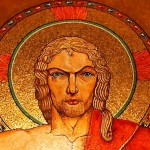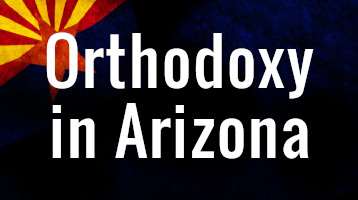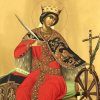![]() by Fr. John A. Peck
by Fr. John A. Peck
How Dogmatic Iconography defends the doctrine of the Incarnation against ancient Gnosticism.
Harold Bloom, in his book, The American Religion, rightly comes to the startling conclusion that America is a nation of Gnostics, believers in a pre-Christian tradition of individual divinity. The American propensity to be religious iconoclasts on the one hand, and cultural idolators on the other is a stark and broken contrast with Incarnational Christianity.
Despite protestations to the contrary, it is not the icon which is so offensive to Gnostics and iconoclasts, it is the message which the icon represents which cannot be tolerated.
Secular Iconography
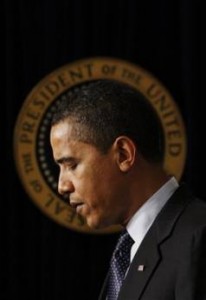
Political Iconography
Sports teams all have logos, pictures and posters of famous players, their own sayings and their own traditions. A high degree of religiosity plays an important part in sports propaganda worldwide. Politics have always used religiosity and iconography, even those who were religious iconoclasts. In communist countries in the last century, giant ‘parades’ (religious processions) with posters (icons) of the glorious leader, the little red books containing the ‘catechism’ of the political movement, and the religious fervor of classic Gnostics (agree, obey or suffer) all were part and parcel of secularist societies. But these were simply replacements for Orthodox icons, Orthodox Christian festal processions, Bibles and prayerbooks. The icons, in this case, were not just destroyed, but deliberately replaced with ‘atheist’ iconography. Because it was based on a falsehood – that the state is supreme – it could not last. Indeed, we see much of the same kind of tactic going on today in America. It is doomed to the same historical failure
Christian Dogmatic Iconography
Before the Incarnation, it was idolatrous to make an image of God. Now that the Incarnation has taken place, it would be idolatrous not to make images of Him.
For example, Muslims reject the Incarnation – the doctrine that God Himself took a human body, mind, soul, spirit – God became a man. Therefore, mosques have bare walls and no images of God. Under their influence, and the resurgence of Gnosticism, many civil authorities in the past engaged in religious iconoclasm. This state-sponsored iconoclasm (literally “image smashing”) was countered by St. John of Damascus (d. 749), Germanus I, Patriarch of Constantinople (d. 732), and St. Theodore the Studite (d. 826), who marshaled scripture and theological thinking in favor of the use of icons in Christian worship. John of Damascus argued that God was the first and original image-maker of the universe and that the son of God was the living image of God in his very nature. Since Paul in the Epistle to the Colossians had written,
“He is the image of the invisible God” (Col. 1:15),
the worship of the icon of Jesus Christ was not idolatrous, because, in the oft-quoted formula of Saint Basil of Caesarea (d. 379) in De Spiritu Sancto (On the Holy Spirit),
“The honor paid to the image [the Son] passes over to the prototype [the Father].”
When a religion rejects images of God, it confirms the message that God is only a spirit, and that He has no physical body. Before the Incarnation, that was true. After the Incarnation, it is false, and is therefore, as false worship, idolatry. Idolatry is worshipping false gods, or worshipping the True God while misrepresenting Him.
In ancient Israel, when people worshiped Baal, Ashtoreth, and Moloch, they committed the first form of idolatry. These are all false gods, and it is idolatry to worship them in any way whatsoever, either with or without images. When the Israelites worshiped the golden calf, they committed the second form of idolatry. They correctly noted the identity of the true God, but they grossly misrepresented Him. Instead of recognizing God as an invisible Spirit, the Israelites made a golden calf, they praised it for delivering them from Egypt, and they even called the calf “Yahweh”.
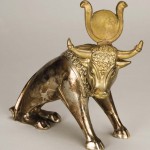
Idol Worship by Any Other Name
When the Israelites sinned with the golden calf, they were still correct that God’s name is “Yahweh”. They were correct that Yahweh had delivered them from Egypt. And they were correct to praise Yahweh. But their worship was turned into idolatry, because they misrepresented Him. God is not a cow, nor does He look like one. Similarly, when heterodox Christians worship with bare walls and an absence of icons, they are correct that God’s name is “Jesus”. They are correct that Jesus came to deliver them from sin. And they are correct to praise Jesus. But their worship is turned into idolatry, because they misrepresent Him. God is no longer a faceless spirit.
Before God became incarnate in the womb of Mary, He had no human body. Images of God were therefore forbidden, because they misrepresented God, but now that God has become incarnate, our worship must reflect this important fact. Otherwise, if we misrepresent God, we become idolaters.
Misrepresenting God: A Grievous Sin
In ancient Israel, God did not want His people bowing down before images of Himself, because any image of Him they made would be misrepresenting Him. But He knew that people needed to bow down before something, so He provided the Temple in Jerusalem for this purpose.
The temple did not represent the image of God, but it did represent His presence.
So God had His people bow down toward the temple:
But I, through the abundance of your steadfast love, will enter your house. I will bow down toward your holy temple in the fear of you. (Psalm 5:7)
Anticipating the day when He would become incarnate, when His people would be able to have images of Himself, God taught His people to include many images in the context of worship. The Jerusalem temple included icons of angels, and early synagogues were covered with icons of many Old Testament saints. The Word had not yet become flesh, so God’s people venerated the Word of God contained in Scripture. Even to this day, Jews bow toward the Torah scrolls when entering/exiting the synagogue, and also during special Torah services. Jews also kiss the Torah to venerate it.
Before the coming of Christ, the Jewish Temple signified God’s presence, and His people bowed down toward it. Before the Incarnation, it was impossible to make an image of the invisible God, a heavenly reality, without misrepresenting Him. Once, however, God became flesh in the Incarnation of Jesus of Nazareth, the invisible God became visible, the immaterial God was suddenly approachable. As is sung in the Nativity hymns of the Orthodox Church during Christmas,
- The uncontainable God is contained in a cave and lies in a manger,
- The unapproachable God summons the Magi to Him,
- The untouchable God nurses at His mother’s breast,
- The invisible God is seen by shepherds, etc.
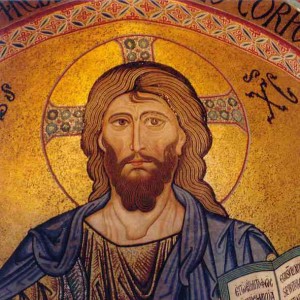
Dogmatic Icon of Christ
It is the reality of the Incarnation which iconography, as sure as the written Scriptures and the liturgical hymns of the Church throughout the ages, protect, defend and guarantee that Christ is understood in one way and one way only – as God the Word come in the flesh.
After Christ came, He referred to His own body as the true Temple. Therefore, instead of continuing to bow down toward a temple building, we now bow down toward images of Jesus. This is not worship of the icon – perish the thought! No Orthodox Christian thinks a piece of wood created heaven and earth. We also bow to one another, because Scripture says that every Orthodox Christian is a temple of the Holy Spirit. When Orthodox Christians bow to an icon of Christ, they are reminded that God is now forever united to a body – the physical flesh of Jesus of Nazareth. Jesus is fully God, and fully human, and He is physically seated in Heaven even today. Orthodox worship represents God correctly.
When others, including heterodox Christians, refuse to bow to icons of Christ, and they choose to bow down before nothing instead, their worship suggests that God has no body, and that the Incarnation hasn’t happened. Their worship misrepresents God. They are bowing down before a faceless idol.
What the Icon Isn’t and What it Is
The Icon is not a ‘holy picture’ designed to increase piety. Neither is an icon something spiritual in itself, as it does not depict “God” in general. The icon is a dogmatic expression of a theological truth. It is, therefore, not variable as artists would claim by ‘artistic license’ – a term I, as an artist, have always found to be a cop out for lack of talent or lack of vision.
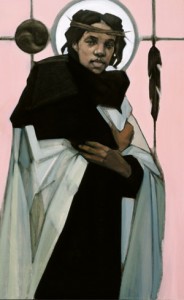
Not a Dogmatic Icon of Christ
Just as one cannot translate the Bible any old way one wishes to and still remain true to the text, one cannot paint an icon any old way one wishes to and still remain true to the prototype.
There are no dogmatic icons of Jesus as Chinese or Jamaican, or with blonde hair and blue eyes. He must always be depicted as he was visible on the earth – a first century Jewish rabbi.
By the same token, the icon is far more than just an attempt to capture a historical person or event. The icon shows the spiritual truth or heavenly reality – not just the image or ‘snapshot’ of history.
Therefore, we never see icons of saints who wore glasses in which they are wearing their glasses. Why not? Presumably, no one wears glasses in heaven, where all may gaze and contemplate upon the glories of heaven.
In the most convincing words of John of Damascus:
“We have passed the stage of infancy, and reached the perfection of manhood. We receive our habit of mind from God, and know what may be imaged and what may not. The Scripture says, “You have not seen the likeness of Him.” (Ex. 33.20) What wisdom in the law-giver. How depict the invisible? How picture the inconceivable? How give expression to the limitless, the immeasurable, the invisible? How give a form to immensity? How paint immortality? How localize mystery? It is clear that when you contemplate God, who is a pure spirit, becoming man for your sake, you will be able to clothe Him with the human form.
When the Invisible One becomes visible to flesh (as in the Incarnation of God in the flesh – John 1:14), you may then draw a likeness of His form. When He who is a pure spirit, without form or limit, immeasurable in the boundlessness of His own nature, existing as God, takes upon Himself the form of a servant in substance and in stature, and a body of flesh, then you may draw His likeness, and show it to anyone willing to contemplate it.
Depict His ineffable condescension, His virginal birth, His baptism in the Jordan, His transfiguration on Tabor, His all-powerful sufferings, His death and miracles, the proofs of His Godhead, the deeds which He worked in the flesh through divine power, His saving Cross, His Sepulchre, and Resurrection, and ascent into heaven. Give to it all the endurance of engraving and color. Have no fear or anxiety.”
Indeed, we see that as American Gnosticism strains to invent a distant, amorphous and ahistorical “concept of God,” Who can never be seen or heard or heard from, it is precisely the dogmatic icon, depicting Christ as He appeared in time, in history, on the earth and among men, which guarantees the Truth of the historical Incarnation that God became flesh and dwelt among us.
The reality is that American Gnosticism clearly denies the objective presence of Christ in the World through Church, Sacrament, and Creed – all vehicles for remaining ‘on the mark’ so to speak. In short, it attempts to make the Incarnation irrelevant.
It is the dogmatic icon which destroys the idolatrous fantasy of Gnostic relativism, and which is, therefore, intolerable to any Gnostic or even to any Christian with Gnostic tendencies. And so it is.
When the Word became flesh, iconoclasm became idolatry. The Incarnation changes everything.
